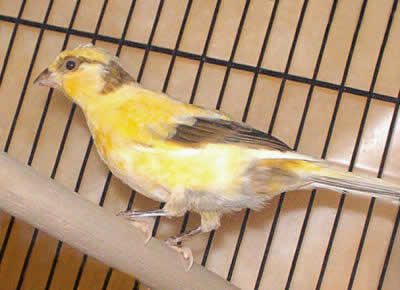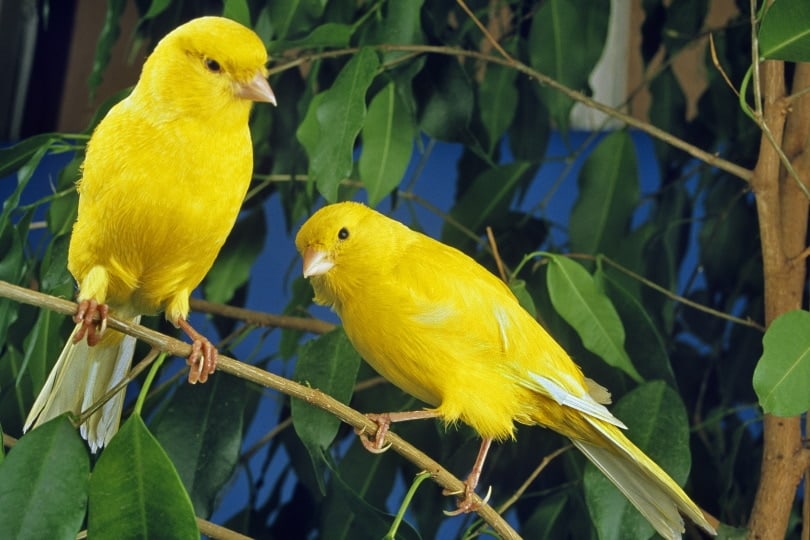
The only canary developed in the United States, the lovely American Singer Canary is considered to be the best canary pet!
The American Singer Canary is not only pleasant to the ear with its melodious song, but pleasant to they eye as well with its striking beauty. By crossing the Border Canary known for its pleasing appearance with the smaller Roller Canary known for its beautiful song, the result was this unique and wonderful bird. A delightful attractive canary with a widely variable song that is sweet and pleasing to the ear, the American Singer is the best of both worlds.
Being an active lively little canary, the America Singer Canary is a good choice for both the beginner and the seasoned keeper. It is strong, hardy, and easy to care for. It is also usually a good breeder and comes in a wide variety of colors.
The American Singer Canary is classed as one of several well known “song canaries”, bred for song rather than physical appearance or color. Shows for these birds are of a different nature than shows for other canary types. Basically being entered into singing contests these canaries are bred with the goal of achieving winners with the best balance between quality and variety of song. Each breed has a distinctive song and a well-defined song standard. Some of the other well know song canaries include: the Roller Canary, Spanish Timbrado, the Russian Singer Canary, and the Waterslager Canary.
For more information about the care of Canaries see:
Guide to a Happy, Healthy Canary
- Kingdom: Animalia
- Phylum: Actiniform
- Class: Elasmobranchii
- Order: Passeriformes
- Family: Fringillidae
- Genus: Serinus
- Species: canaria
Scientific Name:
Distribution:
The American Singer Canary is a newer breed of canary. It was developed in the 1930’s when a group of women who became known as ‘The Eight Boston House Wives” dreamed up the idea of a canary that was both pleasing to the eye and had a beautiful song. They organized a breeding organization devoted to the development of this bird, originally known as the “North American” canary . The canary breeds combined to originate this marvelous breed are the German Roller Canary (30%) and the Border Canary (70%).
This is the most widely spread canary breed in America today. Many of the ‘kitchen’ or ‘common’ canaries found in the United States are descendants of this breed, though only a true breed American Singer will be banded noting it as a pure-bred.
Description:
Though the American Singer Canary is classified as a “song canary”, it is also bred for its appearance. It is a fairly small robust bird reaching a length of about 5 3/4 inches (14.6 cm). They come in a wide variety of colors including yellow, white, buff, green, blue, orange, bronze, brown, fawn, and variegated.
The song of this canary is also of prime importance. The American Singer uses both rolled and chopped notes giving them a very wide variety of song. In showing however, they are judged mainly for their capability to render a song that is pleasing to the ear. It should have just the right amount of blending of roller and border for a pleasant song that is not too loud, harsh, or monotonous.
Canaries of both sexes can begin to sing a weak song as early as four weeks, but females usually don’t sing after about six months and won’t have the full long song of a male.
Care and feeding:
Canaries like wide open spaces so provide a roomy cage. Provide a cage with vertical bars and small perches of different size for foot exercise. Have at least 1 perch set high in the cage for the canary to roost (sleep). The cage should be placed high, so the canary can look down on us so to speak.
Canaries eat mainly canary seed and rape seed. Vitamin coated canary seed mixes are readily available at a pet store. Greens are also enjoyed and can be offered daily along with a little calcium in the form of a cuttlebone.
They do like to bath, so should be offered a bird bath. Cage cleaning and toe nail trimming is about all the maintenance canaries need.
See About Canaries: Housing and About Canaries: Care and Feeding for more information.
Social Behaviors:
Canaries are good-natured social creatures that do well when kept in cages or in aviaries. They are timid birds though and should not be housed with parakeets, lovebirds, or other hookbills that tend to be more aggressive birds by nature.
Male canaries should be kept in a cage by themselves to ensure quality singing. Males can be territorial and pairing up with two male canaries in a cage can cause fights. In a spacious aviary canaries can generally be housed with other canaries, finches, and other hardbills.
Activities:
Canaries do not require toys, mirrors or any other form of entertainment, a swing is all they need to keep themselves occupied. Most of the time, canaries are simply enjoyed for their beauty and singing. However, some canaries are allowed out of their cage to perch or are show canaries and therefore require taming or training.
See About Canaries: Handling/Training for information on taming and training.
Breeding/Reproduction:
The American Singer Canary is generally easy to breed. Most canaries breed easily and readily if provided with quality food, lighting, secure surroundings, and conditioning. Breeding season for most canaries is usually from December to April. They are best bred in breeding cages.They lay their eggs in a nest. The female will lay 3 to 6 eggs, one per day. It is best to allow a hen to have only two clutches.
See About Canaries: Breeding/Reproduction for more information on breeding.
Potential Problems:
These birds are hardy and healthy if provided with a good environment and a good diet. Avoid an environment that is wet, cool, and drafty.
See About Canaries: Potential Problems for information on health.
Availability:
American Singer Canaries were developed in the United States and are not available elsewhere. Often they are available at pet stores, and they can also be readily found through bird shows, bird clubs, breeders, and on the internet.
Featured Image Credit: slowmotiongli, Shutterstock
